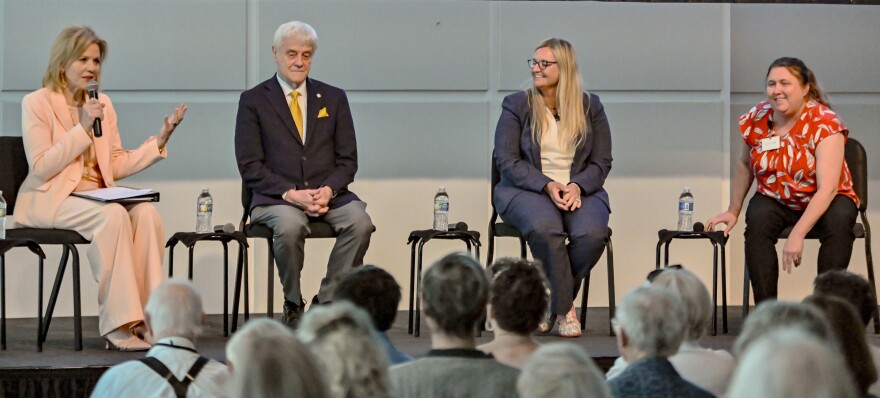The arts are a brain thing. Creative expression heals, can affect our DNA and is underutilized in medicine.
Acclaimed soprano Renée Fleming and three panelists from Sentara Healthcare and Eastern Virginia Medical School expanded on those ideas Monday during a Virginia Arts Festival symposium titled “Music and Mind – Exploring Music and the Arts as Medicine.”
Fleming wrote the 2024 book, “Music and Mind: Harnessing the Arts for Health and Wellness,” a collection of essays from scientists, educators and healthcare providers about the impact of art and music on the human experience. Fleming performed Sunday at the Harrison Opera House.
“Performing arts venues can also be community centers promoting well-being and social connection,” said the five-time Grammy Award winner, who has also been honored with the U.S. National Medal of Arts. “I’m hoping soon to turn on the TV and hear, ‘Ask your doctor if creative arts therapies are right for you. Side effects include better mood, improved cognition and occasional earworm!’”
Paul Aravich, a behavioral neuroscientist and EVMS professor, believes that the arts can play a key role in reducing depression, anxiety and the social isolation experienced not just by dementia patients but also by caregivers.
“I’m afraid to say many of us walk around with our eyes closed and our brains asleep,” said Aravich, who advocates “looking at the world around us from the creative perspective.”

What’s often overlooked, he said, is that while most understand that genes affect behavior, they forget that behavior also affects gene expression, or what’s known as epigenetics. Our brains change when we learn something new, Aravich stressed, and we can become our own genetic engineers by practicing this more regularly.
“Creativity is a fundamental aspect of being who we are, or who we could be, and the arts play a direct role in promoting creativity.”
Aravich sees tremendous potential in moving toward non-pharmacological restraints to treat dementia patients. He supports a person-centered approach called “high-touch, low-tech,” referring to care that focuses on human connection. Aravich would like high-touch, low-tech approaches to become an integral part of the medical school curriculum.
Art therapist Mary Roberts discussed the therapeutic effects that art can have and presented examples of veterans and active military personnel who have experienced trauma and how they benefited from painting.
“Paint is wet. It’s soft. It moves,” she said. “It facilitates expression so it can provide that externalization of emotion.”
Tracy Bowdish, a music therapist at Sentara Neurology Specialists, added that music is a vehicle to drive change, not the final destination. In working with neurologically impaired patients, she is not seeking to make them into musicians.
“You might see someone in my clinic strumming or holding a pick but that’s to work on grip strength,” she said. “You might see someone playing percussion instruments and that might be an attention exercise.”
Noting people’s tendency to tap their toes while listening to music, Bowdish said, is not something we necessarily think about. It’s automatic.
“We are hardwired to respond to sound,” she said. Functional MRIs have found that when people tap their fingers to an auditory rhythm, the brain shows that the rhythm aids in their motor planning. Muscles, in turn, contract more efficiently when a person moves to an auditory rhythm.
That’s helpful in treating Parkinson’s and stroke patients, Bowdish said.
“When we strategically use rhythm to help cue them, not only does the timing of their movement become more precise, they increase their range of motion, their speed, their trajectory.”
As much as the scientific community embraces art and music contributing to the health of the mind, it’s more likely that a doctor will prescribe an $800 Xanax for anxiety rather than having the patient make a playlist or create something visual.
“You would think there would be much more attention to these less costly kinds of intervention,” Aravich said. “That’s where we need social change agents and leaders for the greater good of the community, changing the hearts and minds of members of Congress as well as medical educators.”
Aravich regards Fleming as among those social change agents. While she is best known for a career that spans opera, classical music and singing the national anthem at the 2014 Super Bowl, Fleming is a leading advocate for research at the intersection of arts and health. Every children’s hospital, she said, should invest in creative arts therapy.
Fleming is hopeful funding will continue for the National Institute of Health and its foundation and the World Health Organization toward global support for art and health.
Engaging with the arts has its roots in evolution, Fleming said, noting music likely predates speech. Lullabies are found in every culture. Singing in a choir significantly reduces postpartum depression symptoms. The simple act of singing together lessens cortisol, the stress hormone, and stimulates the vagus nerve in the brain, which can lower blood pressure and improve mood.
“We know that we chanted, danced and drummed our way to social collaboration and survival,” she said. “We know this because a growing body of scientific evidence backed by technology, neuroarts, is the new field that includes all aesthetic experiences, allowing us to flourish, beginning with simply being with nature.”

